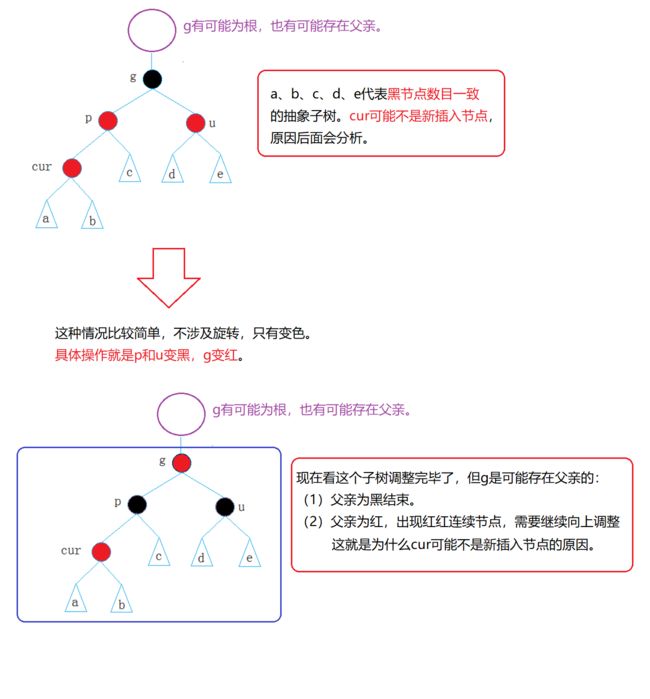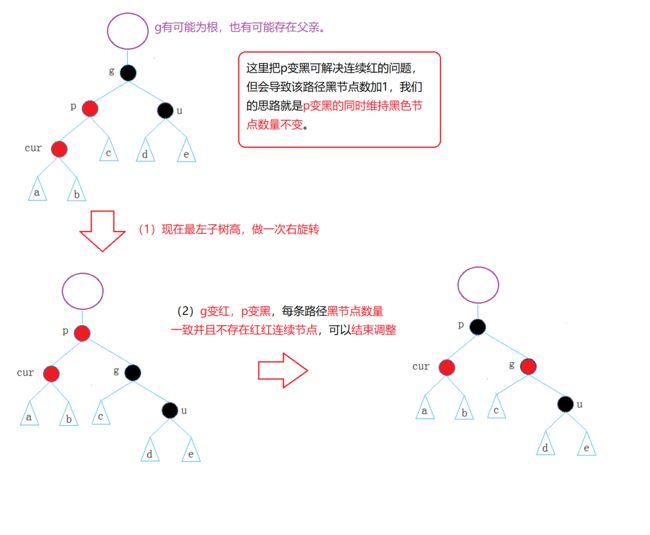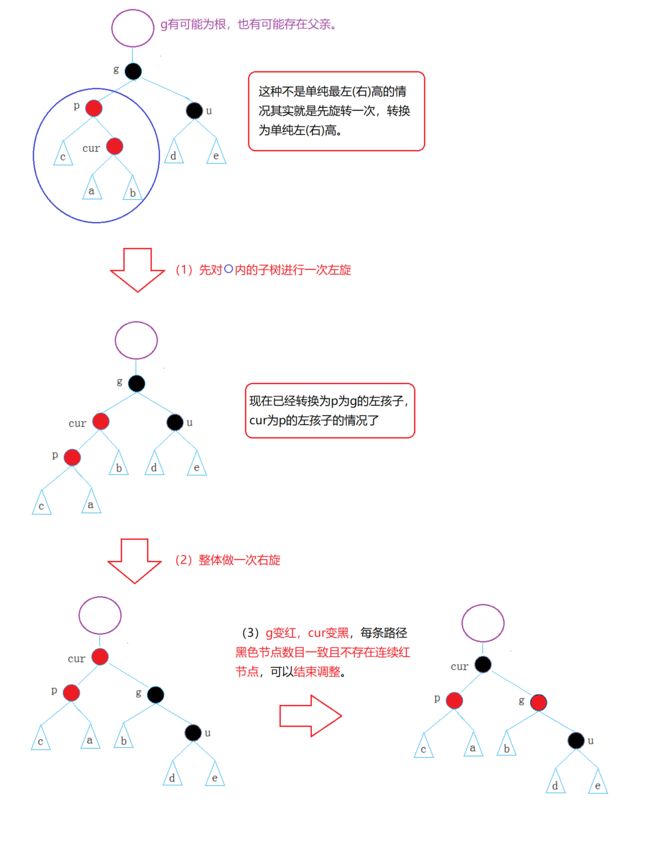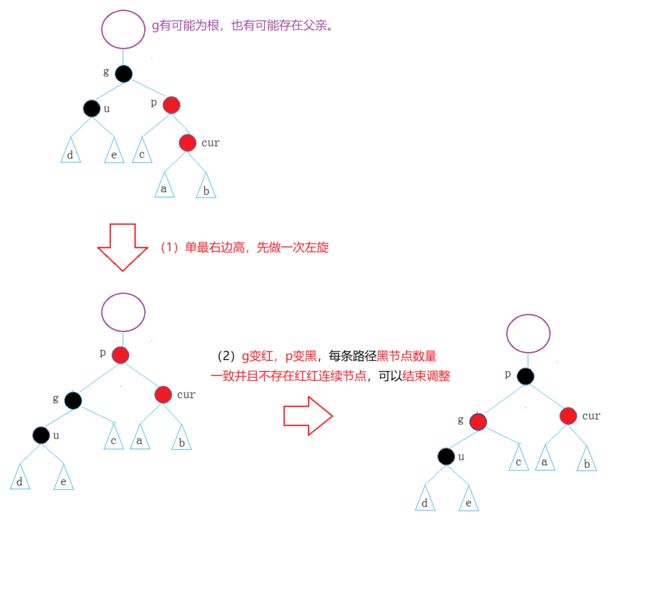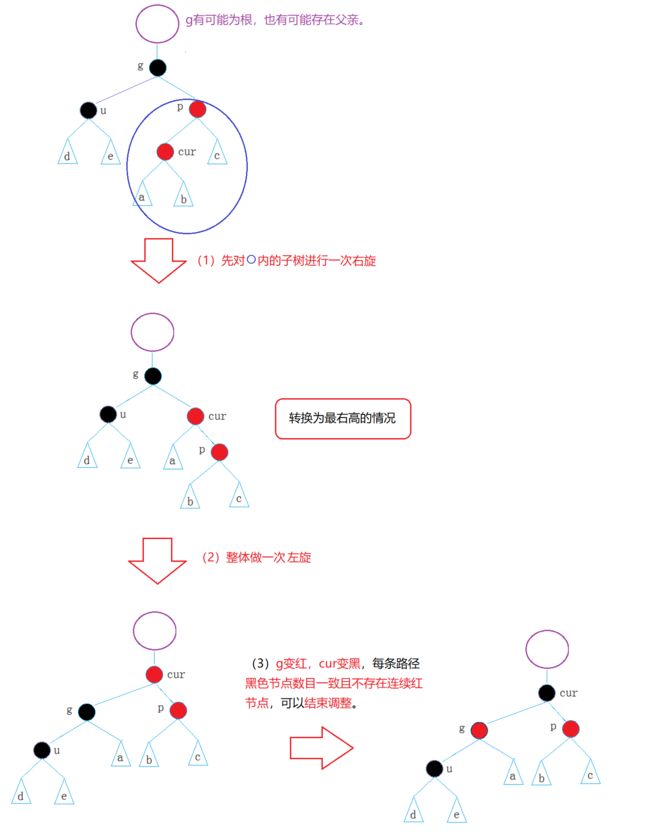数据结构:红黑树讲解(C++)
红黑树
-
- 1.前言
- 2.红黑树简述
-
- 2.1概念
- 2.2性质
- 3.红黑树的插入
-
- 3.1关于新插入节点的颜色
- 3.2节点的定义
- 3.3插入新节点
- 3.4判断插入后是否需要调整
- 3.5插入后维持红黑树结构(重点)
-
- 3.5.1cur、p、u为红,g为黑
- 3.5.2cur、p为红,g为黑,u为空/u存在为黑
- 4.一些简单的测试接口
- 5.完整代码
1.前言
- 本文旨在理解红黑树基本概念以及变色旋转规则,以理解C++map和set的底层原理,不会讲红黑树的删除操作。
- 对于基本的旋转操作(单旋和双旋),本文不会展开讲,详细讲解在这里:
AVL树旋转讲解。
2.红黑树简述
2.1概念
红黑树,是一种二叉搜索树,但在每个结点上增加一个存储位表示结点的颜色,可以是Red或Black。 通过对任何一条从根到叶子的路径上各个结点着色方式的限制,红黑树确保最长路径不超过最短路径两倍,因而是接近平衡的。
2.2性质
- 每个节点不是红色就是黑色。
- 根部节点是黑色的。(为了减少旋转次数,后面讲旋转大家就明白了)
- 对于一个红节点,它的孩子只能是黑色。(即一条路径上不能出现连续的红色节点)
- 每条路径都必须包含相同数量的黑色节点。
通过上面规则的限制,红黑树最长路径一定不会超过最短路径两倍,也就维持了高度的相对平衡。
结合3、4来看下面的两条路径:
最长:黑、红、黑、红、黑、红…………
最短:黑、黑、黑…………
3.红黑树的插入
3.1关于新插入节点的颜色
对于新插入节点,我们设置为红色,原因是红黑树每条路径都必须包含相同数量的黑色节点(性质4),新插入红节点不一定破坏红黑树的结构,新插入黑色节点一定不符合性质4而且很难调整。
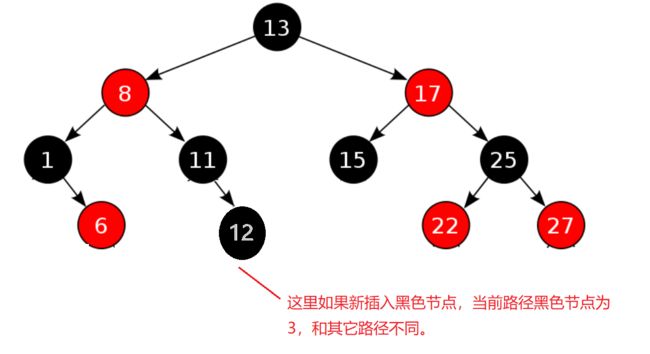
3.2节点的定义
//用枚举来定义颜色
enum Color
{
RED,
BLACK
};
//这里直接实现key_value模型
template<class K, class V>
struct RBTreeNode
{
RBTreeNode<K, V>* _left;
RBTreeNode<K, V>* _right;
RBTreeNode<K, V>* _parent; //涉及到旋转,多加父亲指针来简化操作
pair<K, V> _kv; //存储键值对
Color _col; //颜色
RBTreeNode(const pair<K, V>& kv)
:_left(nullptr)
, _right(nullptr)
, _parent(nullptr)
, _kv(kv)
,_col(RED) //新节点颜色为红色
{}
};
3.3插入新节点
这里比较简单,按二叉搜索树的规则插入即可:
bool Insert(const pair<K, V>& kv)
{
if (_root == nullptr)
{
_root = new Node(kv);
_root->_col = BLACK;
return true;
}
Node* cur = _root;
Node* parent = nullptr;
while (cur)
{
if (kv.first > cur->_kv.first) //待插入节点在右子树
{
parent = cur;
cur = cur->_right;
}
else if (kv.first < cur->_kv.first) //待插入节点在左子树
{
parent = cur;
cur = cur->_left;
}
else //相同
{
return false;
}
}
cur = new Node(kv);
if (kv.first > parent->_kv.first) //新节点在父亲右子树
{
parent->_right = cur;
}
else //新节点在父亲左子树
{
parent->_left = cur;
}
cur->_parent = parent; //记得更新父亲指针
/// 变色旋转维持红黑树结构(暂时省略) //
_root->_col = BLACK; //可能改变根部颜色,保持根部为黑色
return true;
}
3.4判断插入后是否需要调整
其实红黑树插入后只需要看当前节点和父亲的颜色即可,其中新节点一定为红。
- 父亲为黑,符合规则,不需要调整。
- 父亲为红,此时出现红红的连续节点,需要进行调整。
3.5插入后维持红黑树结构(重点)
为了方便叙述,我们做如下定义:
- cur表示当前节点
- p表示cur父亲节点
- u表示叔叔节点
- g表示祖父(p和u的父亲)节点
3.5.1cur、p、u为红,g为黑
while (parent && parent->_col == RED) //父亲为红就调整,调整到根部要结束
{
Node* granderfather = parent->_parent; //祖父
//需要对叔叔进行操作,需要判断叔叔是祖父的左还是右
if (parent == granderfather->_left) //父亲是祖父的左子树
{
Node* uncle = granderfather->_right;
if (uncle && uncle->_col == RED) //叔叔不为空并且叔叔为红,变色即可
{
uncle->_col = parent->_col = BLACK;
granderfather->_col = RED;
//当前子树可能为部分,继续向上调整
cur = granderfather;
parent = cur->_parent;
}
else //叔叔为空或为黑色
{
//先省略
}
}
else //父亲是祖父的右子树
{
Node* uncle = granderfather->_left;
if (uncle && uncle->_col == RED) //叔叔不空并且为红
{
parent->_col = uncle->_col = BLACK;
granderfather->_col = RED;
//当前可能为部分子树,需要继续上调
cur = granderfather;
parent = cur->_parent;
}
else //叔叔为空或为黑色
{
// 先省略
}
}
}
3.5.2cur、p为红,g为黑,u为空/u存在为黑
下面是一会要用到的旋转接口:
void RotateL(Node* parent) //左单旋,rotate->旋转
{
Node* SubR = parent->_right;
Node* SubRL = SubR->_left; //这个有可能为空
Node* ppnode = parent->_parent; //原来父亲的父亲
parent->_right = SubRL;
if (SubRL) SubRL->_parent = parent;
SubR->_left = parent;
parent->_parent = SubR;
if (ppnode == nullptr) //旋转的是整颗树
{
_root = SubR;
SubR->_parent = nullptr;
}
else //旋转的是部分
{
if (ppnode->_left == parent) //是左子树
{
ppnode->_left = SubR;
}
else //是右子树
{
ppnode->_right = SubR;
}
SubR->_parent = ppnode;
}
}
void RotateR(Node* parent) //右单旋细节处理和左单旋差不多
{
Node* SubL = parent->_left;
Node* SubLR = SubL->_right; //这个有可能为空
Node* ppnode = parent->_parent;
parent->_left = SubLR;
if (SubLR) SubLR->_parent = parent;
SubL->_right = parent;
parent->_parent = SubL;
if (ppnode == nullptr) //旋转的是整颗树
{
_root = SubL;
SubL->_parent = nullptr;
}
else //旋转部分
{
if (ppnode->_left == parent) //是左子树
{
ppnode->_left = SubL;
}
else //右子树
{
ppnode->_right = SubL;
}
SubL->_parent = ppnode;
}
}
涉及旋转情况比较复杂,分开讨论:
(2)p为g的左孩子,cur为p的右孩子
(3)p为g的右孩子,cur为p的右孩子
(4)p为g的右孩子,cur为p的左孩子
整合一下(1、2、3、4)得到下面的调整代码:
//到这里插入新节点的工作完成,下面进行结构调整:
while (parent && parent->_col == RED) //父亲为红就调整,调整到根部要结束
{
Node* granderfather = parent->_parent; //祖父
if (parent == granderfather->_left) //父亲是祖父的左子树,p为g的左孩子
{
Node* uncle = granderfather->_right;
if (uncle && uncle->_col == RED) //叔叔不为空并且叔叔为红,变色即可
{
uncle->_col = parent->_col = BLACK;
granderfather->_col = RED;
//当前子树可能为部分,继续向上调整
cur = granderfather;
parent = cur->_parent;
}
else //叔叔为空或为黑色
{
// g
// p u
// c
if (cur == parent->_left) //当前为父亲的左子树,cur为p的左孩子
{
RotateR(granderfather);
granderfather->_col = RED;
parent->_col = BLACK;
}
else //当前为父亲的右子树,cur为p的右孩子
{
// g
// p u
// c
//左右双旋
RotateL(parent);
RotateR(granderfather);
granderfather->_col = RED;
cur->_col = BLACK;
}
break; //这两种情况调整完可以结束
}
}
else //父亲是祖父的右子树,p为g的右孩子
{
Node* uncle = granderfather->_left;
if (uncle && uncle->_col == RED) //叔叔不空并且为红
{
parent->_col = uncle->_col = BLACK;
granderfather->_col = RED;
//当前可能为部分子树,需要继续上调
cur = granderfather;
parent = cur->_parent;
}
else //叔叔为空或为黑色
{
if (cur == parent->_right) //当前为父亲的右,cur为p的右孩子
{
// g
// u p
// c
//左旋
RotateL(granderfather);
parent->_col = BLACK;
granderfather->_col = RED;
}
else //当前为父亲的左,cur为p的左孩子
{
// g
// u p
// c
//右左双旋
RotateR(parent);
RotateL(granderfather);
cur->_col = BLACK;
granderfather->_col = RED;
}
break; //这两种情况调整完可以结束
}
}
}
_root->_col = BLACK; //保持根部为黑色
4.一些简单的测试接口
void InOrder() //中序遍历,验证是否为二叉搜索树
{
_InOrder(_root);
cout << endl;
}
void _InOrder(Node* root)
{
if (root == nullptr)
return;
_InOrder(root->_left);
cout << root->_kv.first << " ";
_InOrder(root->_right);
}
// 根节点->当前节点这条路径的黑色节点的数量
bool Check(Node* root, int blacknum, const int refVal)
{
if (root == nullptr) //到根部看看当前路径黑色节点和标准值是否一致
{
//cout << balcknum << endl;
if (blacknum != refVal)
{
cout << "存在黑色节点数量不相等的路径" << endl;
return false;
}
return true;
}
/检查子比较复杂,可以反过来去检查红节点父是否为黑色
if (root->_col == RED && root->_parent->_col == RED)
{
cout << "有连续的红色节点" << endl;
return false;
}
if (root->_col == BLACK)
{
++blacknum; //为黑节点加一
}
return Check(root->_left, blacknum, refVal)
&& Check(root->_right, blacknum, refVal);
}
bool IsBalance()
{
if (_root == nullptr)
return true;
if (_root->_col == RED)
return false;
//参考值,即先算出一条路径的黑色节点数
int refVal = 0;
Node* cur = _root;
while (cur)
{
if (cur->_col == BLACK)
{
++refVal;
}
cur = cur->_left;
}
int blacknum = 0;
return Check(_root, blacknum, refVal);
}
5.完整代码
#pragma once
#include 